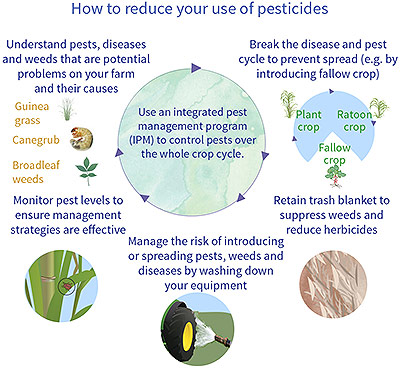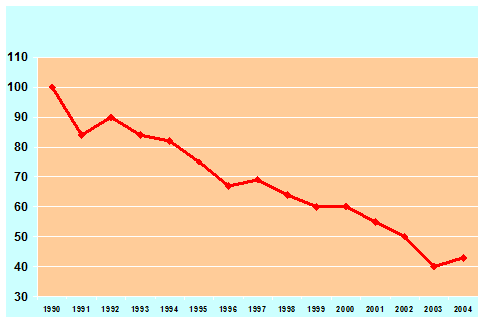2.1
Pesticides
Today Europe accounts for almost a quarter of the growing global pesticide market, with the vast majority of products applied in the agricultural sector. The three main classes – herbicides, fungicides and insecticides – are used to protect plants from weeds, fungi and insects. Their application rates vary depending on farmers „training and on the crops“ characteristics. Grapes, for example, are a fungicide-intensive crop, and tulips – widespread in the Netherlands – are pesticide-intensive due to their value and high pest pressure. Introduced in the 1940s, synthetic pesticides have been evolving ever since. In the early 90s, new EU regulations led to the withdrawal of various compounds, some of which were replaced by more effective products used at lower dosages, leading in some countries to a slight reduction in the volume of pesticide used. Across Europe, various incentives encourage low-pesticide farming: Sweden and Norway both introduced targeted tax schemes in the 1980s, followed by France and Denmark in the late 2000s, though with limited effectiveness. Belgium, Switzerland, the Netherlands and Germany have recently discussed similar measures. Organic farming is one of the ways to reduce pesticide use. 2014 organic farming accounted for 5.4 per cent of the total agricultural area, which is by 2.3 per cent more than in the previous year.
19. The pesticide champions in Europe, 2016 (http://www.technologist.eu/the-pesticide-champions/)

20. Reef protection regulations, 2018 (https://www.qld.gov.au/environment/agriculture/sustainable-farming/canefarming-impacts#) The massive use of pesticides in fruit and vegetables and the cocktails applied are reflected in our food. Currently 27 per cent of all fruit and vegetables contain multiple residue (cocktails of pesticides); a bucket of strawberries or a bunch of grapes could easily contain 10 – 15 pesticides. Also the maximum number of pesticides found in one food item is at the almost unbelievable level of 28 as is shown in graph below. European consumers will be exposed to a daily dose of pesticide cocktails as a consequence. In 2013 the percentage of multiple residues in European vegetables and fruit increased again to the extreme high rate of 27,3 per cent. Unfortunately EFSA stopped publishing the data on the highest reported number of different pesticides in one sample.

21: Pesticide Use in Europe, 2013 (https://www.pan-europe.info/issues/pesticide-use-europe) As a consequence of the industrial agriculture no place is left for natural life. Monocultures from maize, grass, potaties, bulbs, massive use of pesticides and fertilizers make life for animals and herbs impossible. Food (insects, seeds) is not available anymore or poisoned, place to shelter (hedges, trees, buffer zones) gone and crop growing will take all place available. Birds, mammals, bees and all natural life has more or less disappeared in the agricultural areas, like the Skylark, for ages an abundant bird in the European fields and now threatened to extinction (see graph).

Number of skylarks in the Netherlands (1990 = 100%)
22. Pesticide Use in Europe, 2013 (https://www.pan-europe.info/issues/pesticide-use-europe) Not only birds, but also a large number of wildlife species is in danger for agricoltural synthesis compounds spread , first of all honey bees. The increasing of pesticide consumption during the last four decades and the side effects one of which is the toxicity to honey bees. According to a study in the UK, pesticides damage the ability of bees to gather food and are also killing them. Since bees are the most important pollinators of crops, the use of pesticides can considerably reduce the yield of cross pollinated crops. In addition to the above effects, contamination of bee products, and loss in production of honey are the other effects caused by pesticides on bees. Unfortunately, many pesticides are harmful to bee population. There are some pesticides that kill the bees directly. This occurs when bees are on the flowers at the time of application of the insecticide and the bees die instantly. Some other types of pesticides allow the bees to return home and then they die. Such types are easy to identify than the first ones. There are certain pesticides that do not have any effect on the adult honey bees, but cause damage to young, immature bees. According to research, two pesticides commonly used by farmers today could affect bees brains. The two pesticides namely, neonicotinoids and coumaphos target bees brains, thus making it a slow learner and make the it forget floral scents. They also found that, the combination effect of these two pesticides were far greater than individual effect. Bees that were exposed to combined insecticides, were slow to learn or sometimes completely forgot important associations between their ability to nectar and floral scent.

23. What is harming the bees? 2018 (https://www.syngenta.com/) The neonicotinoids are a relatively new class of pesticides that have an effect on the bee’s central nervous system. It is the most widely used insecticide in US, which is used as a coating in agricultural seeds and in potted plants. It spreads to the whole plant including pollen and nectar that the bees eat. Scientific studies indicate that the bees that feed on neonicotinoid contaminated pollen and nectar forage less and produces fewer offspring. The other insecticide, coumaphos, is a compound that is used in honey bee hive to kill a parasite called the Varroa mite that commonly attacks honey bees. A study of the honey bee's genome published in 2006 in the journal Genome Research says honey bees have 170 odorant receptors that can help them sniff out and distinguish different types of flowers — so it's important to understand how critical a bee's sense of smell is to its ability to find food. The results of Penn State researchers' computer simulations showed that even a moderate level of air pollutant such 60 parts per billion of ozone can change a floral scent composition and make it harder for bees to find their next food source. This alteration could have a dramatic effect on bees' foraging habits and food supplies that could create "severe cascading and pernicious impacts on the fitness of foraging insects by reducing the time devoted to other necessary tasks," the study's abstract suggests. Jose D. Fuentes, a professor of meteorology and atmosphere science at Penn State and lead author on the study, says that floral scents need to be able to travel a great distance in order for bees to find them. He estimates that the nests of bees and other insects that pollinate flowers can be located up to 3,000 feet away from their nearest food source. So a pollutant that degrades the quality of a floral scent and lessens its reach could have a dramatic effect on bees' pollination habits and patterns, Fuentes says. "We found that when we confused the bees' environment by modifying the gases present in the atmosphere, they spent more time foraging and would bring back less food, which would affect their colonies," Fuentes says. "It's similar to being asked to get a cup of coffee at the nearest cafeteria while you are blindfolded. It will be hard to locate the coffee shop without using visual cues. The same could happen to insect pollinators while foraging for food in polluted air masses.” The absence of insect pollination would cut the production of crops that are partially dependent on insect pollination by around 25–32 % (Zulian et al., 2013).